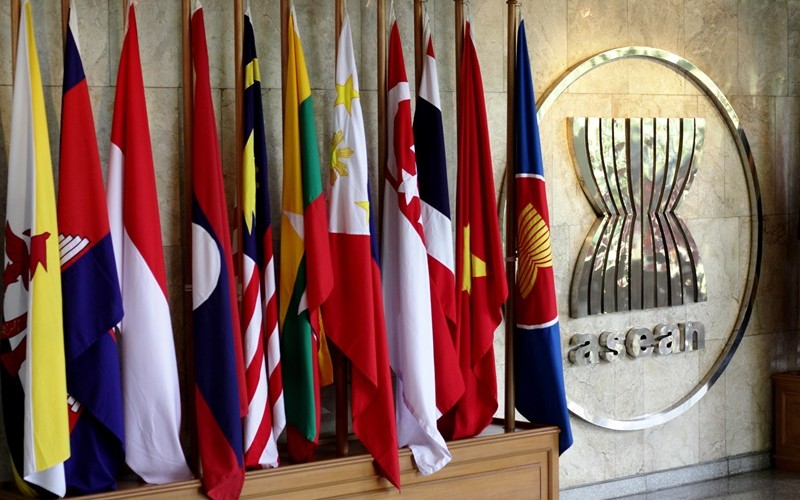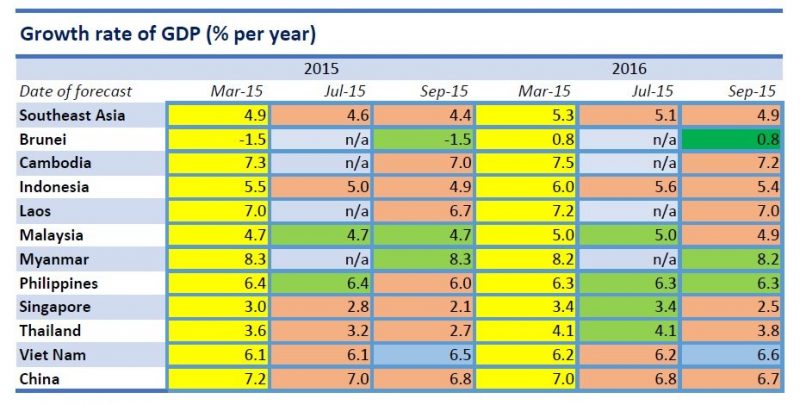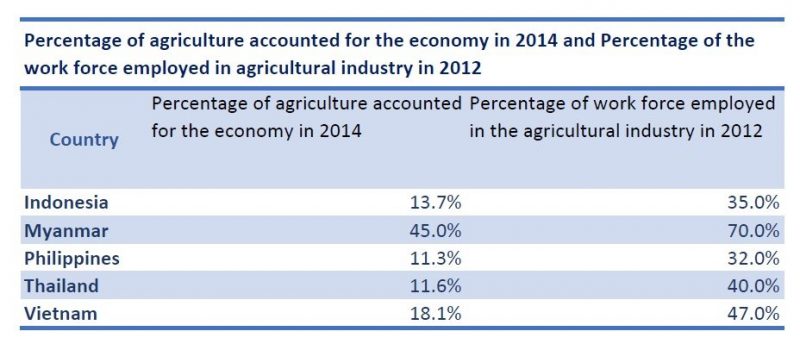Last week, the Asian Development Bank downgraded the 2015/2016 growth rate forecasts for most ASEAN countries, and the region as a whole. The latest revised figures revel some of the risks that continue to challenge growth prospects in the region.

Sub-regional growth has been revised down to 4.4 percent from an initial forecast of 4.9 percent, owning to various domestic factors such as disappointing growth in Thailand, slow government spending in Indonesia and the Philippines, wavering business confidence in Malaysia, and external shocks such as falling global energy prices and slowing growth in China.
(Source: Asian Development Outlook Supplement, July 2015, Asian Development Outlook 2015 Update: Enabling Women, Energizing Asia. Key: yellow: initial forecast in March, green: forecast unchanged, red: downward revision, blue: upward revision)
The latest cut in growth figures underlines the major risks and uncertainties that continue to weaken growth prospects in Southeast Asia. Five risks in particular will threaten growth in the ASEAN.
- Internal political struggles
The Asian Development Bank (ADB) has reported slowed government spending in the region, as well as waning business confidence. For instance, Indonesia is dealing with a political struggle between the ruling coalition and opposition camp in the House of Representatives. This in turn has hampered projections for government infrastructure spending for much of 2015.
Similarly, public spending will gradually accelerate but is expected to miss government targets. Furthermore, due to lack of unity within his administration, President Joko “Jokowi” Widodo has reshuffled his cabinet.
Thailand’s level of public spending is recovering from the political disruptions in 2014, and has started to pick up this year, but projections still lag behind goals. The 1MDB corruption scandal in Malaysia has led to a deprecation of the Ringgit, and has undermined business confidence.
- Elections generate post-election uncertainties
November elections in Myanmar and 2016 elections in the Philippines also add uncertainty to the growth prospects in those countries. The ADB sees greater than usual uncertainty for the Philippines; business is concerned as to whether a new administration would continue with the current economic reform agendas. Particular concern exists in the infrastructure, social welfare, and education sectors, where the current administration has made significant progress.
In the case of Myanmar, businesses are concerned about who will be president following the historic election in November this year. The role of the military is expected to remain dominant, while Aung San Suu Kyi, though constitutionally barred from the highest post, is expected to see her party (NLD) perform well.
Hence, the power struggle between the military and pro-democracy political parties will persist.
- Droughts and floods hurt agriculture
Southeast Asia is one of the world’s most disaster prone regions, yet is also heavily reliant on agriculture. Floods and droughts caused by El Niño in several Southeast Asian countries have hurt the agricultural sector. Myanmar has experienced the worst floods in decades this year, and is expected to see both production and export reductions for rice and other crops.
In Thailand, drought has hit agricultural output hard. With declining rural incomes and high household debt, private consumption in 2015 will be slow. Similarly, Indonesia is suffering its worst drought since 2010; with as much as 80% of the country affected. The Philippines also saw no year-on-year growth in agricultural production in the first half of 2015. Drought conditions in Vietnam have also damaged coffee and rice production and if prolonged could further weaken growth in the agricultural sector while pushing up food prices into 2016.
(Source: World Bank, and Oxford Business Group)
- Low energy prices retard government revenues
Falls in prices for energy and other commodities have also hurt the growth of some ASEAN countries. Low oil and gas prices have crumpled government income in Brunei, which relies on hydrocarbons for two-thirds of its GDP. The ADB has reported that export revenue for crude oil, refined petroleum products, and liquefied natural gas in Malaysia plummeted, the result of the steep drop in oil and gas prices.
- Slow growth in China hurts ASEAN
ADB has also cut down the growth forecasts for China from 7.2 percent in March down to 6.8 percent for 2015, and from 7 percent to 6.7 percent for 2016. China is the largest trading patenr of many Southeast Asian countries, and the largest partner of ASEAN, as a whole. Weak demand from China has undermined exports performance in many Southeast Asian countries.
Optimism remains
While the ADB has slashed growth forecasts for the region for 2016, it expects growth to rebound in 2016 to 4.9 percent with improvements in exports and accelerated infrastructure spending.
The inauguration of the ASEAN Economic Community at the end of this year will also see a strengthening of trade links between member countries and a step towards an integrated market.
Tourism, one of the vital industries of many SEA countries, has also remained resilient and continues to drive growth, particularly in Thailand, Cambodia, and the Philippines.
sourche: http://globalriskinsights.com/2015/10/five-risks-to-asean-growth/


Δεν υπάρχουν σχόλια:
Δημοσίευση σχολίου